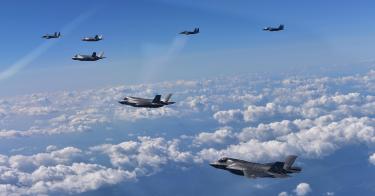Last Friday, the Air Force announced plans to buy Boeing’s F-15X, based on the jet’s capabilities and comparatively low costs when stacked against the F-35A.
Is this a wise investment? Let’s take a look.
The Air Force needs to acquire at least 72 fighters a year just to offset jets that are aging out. The largest number of F-35s it plans to purchase in any given year is 60, starting in 2026, and there’s no question the service needs to buy more jets. So does it make sense for the USAF to buy the F-15X?
Let’s first consider the costs.
The F-15K, the Korean variant of the F-15E, was estimated to cost more than $100 million a copy in 2006, without the electronically scanned array radar and other expensive upgrades the F-15X would include. Conversely, F-35As purchased next year and fielded in 2022 are projected to cost less than $80 million a copy — a price-per-aircraft differential of $20 million.
Assuming Boeing sells an upgraded F-15X for the price of an F-15K, that differential would have to be made up by the savings in new equipment and facilities that would not be needed since the F-15 is already part of the USAF inventory, as well that jet’s operating costs, generally measured in flying hours.
At first blush, it’s hard to see how the F-15X could be cheaper — but for just argument’s sake, let’s say the Air Force could both buy and operate the F-15X below the price of the F-35. Are the capabilities of the F-15X even worthy of the investment?
The F-15 is a capable platform that has served the nation well. It enjoyed several upgrades since it was introduced in 1977. The most substantial came in 1989 when the F-15E was fielded as a multirole fighter. The modification added conformal fuel tanks for longer range, and a targeting pod for precision weapons delivery.
After the Air Force accepted its last F-15E in 1992, orders from South Korea, Israel, the United Arab Emirates, Saudi Arabia, and Qatar kept the production line humming. With every order came upgrades to the F-15’s engines, radar, suite of electronic countermeasures, and other subsystems.
As envisioned, the F-15X will include all those improvements, while carrying a veritable arsenal of air-to-ground and air-to-air munitions including up to 22 air-to-air missiles. With both conformal and external drop tanks, the jet has a range of 600 miles, equaling that of an F-35A.
Many, including Air Force Chief of Staff Gen. David L. Goldfein, talk of the F-15X as a replacement for the Air Force’s F-15C. Unfortunately, the added weight and drag of the modifications that give the F-15X its superb range and suite of capabilities have also caused it to lose the agile handling characteristics and favorable thrust-to-weight ratio associated with its older, air superiority sibling.
The F-15X is an updated version of the F-15E, and six active duty pilots I have interviewed who have flown both that jet and the F-35 state the former could never survive in a modern day, high-threat environment, and that it would be soundly defeated by an F-35 in almost any type of air-to-air engagement. That strongly suggests buying the F-15X in lieu of the F-35 would be a very poor choice.
It is hard to imagine any high-end scenario where fighters will be able to operate outside of the threat rings of surface-to-air missiles. Even with the threat in places like Syria, stealth is becoming a prerequisite for survival.
By some estimates, the next generation of Russian and Chinese air-to-air missiles will out-range ours by some measure. While an F-15X’s arsenal of 22 air-to-air missiles is formidable, it might not live long enough to target a fourth-generation Russian or Chinese fighter, much less even see their fifth-generation fighters that will guard every conceivable avenue of approach 12 years from now.
Those facts alone relegate the F-15X to low-threat operations in places where a light attack aircraft is arguably more suitable. Unfortunately, reportedly there is not even enough money in the current budget environment to field that markedly cheaper platform. In the unforgiving world of conflict, investments have to deliver viable combat capability, and in that regard the F-15X falls well short of the mark.
Still, the Air Force needs to buy 72 fighters a year just to keep pace with aircraft retirements, not to mention address the need to grow new squadrons as Air Force Secretary Heather Wilson has said is required.
For the reasons described above, Congress should be very skeptical of plans to buy a legacy fighter such as the F-15X and, at the very least, debate the idea of expanding F-35 production capacity to meet the needs of the Air Force. The cost of any new fighter we acquire should allow us to take the fight to the enemy on our terms for the next quarter-century.
This piece originally appeared in The Washington Examiner



